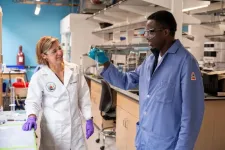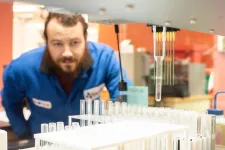(Press-News.org) Mustard gas, also known as sulfur mustard, is one of the most harmful chemical warfare agents, causing blistering of the skin and mucous membranes on contact. Chemists at Washington University in St. Louis have been awarded a $1 million contract with the Defense Threat Reduction Agency (DTRA) to develop a new way to detect the presence of this chemical weapon on the battlefield.
As with many chemical threats, quick identification of sulfur mustard is key to minimizing its damage, according to Jennifer Heemstra, the Charles Allen Thomas Professor of Chemistry in Arts & Sciences and principal investigator of the new DTRA grant.
“It’s important to be able to detect sulfur mustard, because once people are exposed, there is no antidote,” Heemstra said. “Detection is key to preventing exposure, and currently there aren’t good technologies to do that rapidly in the field.”
Mustard gas was used during combat in World War I, World War II and the Iran-Iraq conflict in the 1980s. Exposure to mustard gas does not often cause death, but it can cause temporary or permanent eye injury, second- and third-degree burns and other serious problems with breathing.
Even after a war is over, service members, contractors and civilians who demolish or handle explosive ordinance can be exposed to mustard agents. Current methods for detecting sulfur mustard require expensive instrumentation and specialized sample preparation, making them impractical for the type of real-time detection that is needed in the field.
Under the new grant, Heemstra and her collaborators, including M.G. Finn at Georgia Institute of Technology, will develop a new, streamlined way to detect an entire class of chemical compounds called vesicants, a group that includes sulfur mustard.
“We will initially focus on model compounds that act like mustards, but that can be handled safely in the laboratory. This will allow us to test different molecular sensor designs, with the Heemstra lab and ours working together on complementary approaches,” Finn said. Other key project team members include Joseph Ibukun, a postdoctoral research associate at WashU; Seth Taylor, a postdoctoral research associate at Georgia Tech; and Makenzie Walk, a graduate student at WashU.
The scientists will use nucleic acid molecular recognition to generate biomolecules that first bind to specific vesicants and then initiate a cascade of reactions that will generate a highly visible fluorescent signal.
“Often sensors have a simple, linear output — as in, the one molecule you detect produces one molecule of signal on the other end,” Heemstra said. “Here we are planning to generate an amplified output, so that for every molecule of toxin, you’re generating several signal molecules so that you can detect them with the naked eye.”
Her collaborators at Georgia Tech have specialized experience in producing amplified signals using dendrimers — synthetic molecules with a highly ordered, branch-like structure.
“For this kind of branched chain molecule, you generate more and more branches with every generation,” Heemstra said. “After one reaction with a toxin molecule, we hypothesize that we can trigger a cascading reaction that will then release dye molecules at the end of each of the branch points.”
Countering weapons of mass destruction is important for military personnel, but this research can lead to outcomes that are important for civilians as well.
Heemstra points to the example of another chemical weapon, sarin, which was used during the Iran-Iraq conflict. In military conflict, it is used at high doses and can cause death in minutes. But certain organophosphate pesticides can have a similar structure and biological mechanism as sarin, just with lower toxicity. Over time, people exposed to such pesticides can suffer from chronic organophosphate poisoning.
“Milder versions of the types of toxins that are used in warfighting and as chemical weapons show up in everyday life,” Heemstra said. “When they’re not handled properly, they can be a real threat to society and to human health.”
About the Defense Threat Reduction Agency: DTRA is a defense agency that provides cross-cutting solutions to enable the Department of Defense, the U.S. government and international partners to deter strategic attack against the United States and its allies; prevent, reduce and counter weapons of mass destruction and emerging threats; and prevail against weapons of mass destruction-armed adversaries in crisis and conflict. In fiscal year 2024, WashU received more than $15 million in contract awards with the Department of Defense.
END
WashU to develop new tools for detecting chemical warfare agent
2025-02-13
ELSE PRESS RELEASES FROM THIS DATE:
Tufts researchers discover how experiences influence future behavior
2025-02-13
Neuroscientists have new insights into why previous experiences influence future behaviors. Experiments in mice reveal that personal history, especially stressful events, influences how the brain processes whether something is positive or negative. These calculations ultimately impact how motivated a rodent is to seek social interaction or other kinds of rewards.
In a first of its kind study, Tufts University School of Medicine researchers demonstrate that interfering with the neural circuits responsible ...
Engineers discover key barrier to longer-lasting batteries
2025-02-13
Lithium nickel oxide (LiNiO2) has emerged as a potential new material to power next-generation, longer-lasting lithium-ion batteries. Commercialization of the material, however, has stalled because it degrades after repeated charging.
University of Texas at Dallas researchers have discovered why LiNiO2 batteries break down, and they are testing a solution that could remove a key barrier to widespread use of the material. They published their findings online Dec. 10 in the journal Advanced Energy Materials.
The team plans first to manufacture LiNiO2 batteries in the lab and ...
SfN announces Early Career Policy Ambassadors Class of 2025
2025-02-13
WASHINGTON — The Society for Neuroscience (SfN) has selected 10 members from a highly competitive applicant pool to participate in the Society’s annual Capitol Hill Day on March 11–13, 2025. The 10 Early Career Policy Ambassadors (ECPAs), representing many career stages and geographic locations, were chosen for their dedication to advocating for the scientific community, their desire to learn more about effective means of advocacy, and their experience as leaders in their labs and community.
The ambassadors are:
Izan Chalen, University of Illinois Urbana-Champaign
Nicole D’Souza, University of California, Riverside
Lana Ruvolo Grasser, PhD, Department ...
YOLO-Behavior: A new and faster way to extract animal behaviors from video
2025-02-13
Collecting video data is the long-established way biologists collect data to measure the behaviour of animals and humans. Videos might be taken of human subjects sitting in front of a camera while eating in a group in the University of Konstanz, or researchers using cameras to measure how often house sparrow parents visit their nests on Lundy Island, UK. All these video datasets have one thing in common: after collecting them, researchers need to painstakingly watch each video, manually mark down who, where and when each behaviour of interest happens—a process known as “annotation”. ...
Researchers identify a brain circuit for creativity
2025-02-13
KEY TAKEAWAYS
Brigham researchers analyzed data from 857 patients across 36 fMRI brain imaging studies and mapped a common brain circuit for creativity.
They derived the circuit in healthy individuals and then predicted which locations of brain injury and neurodegenerative disease might alter creativity.
The study found that changes in creativity in people with brain injury or neurodegenerative disease may depend on the location of injury in reference to the creativity circuit.
A new study led by ...
Trends in obesity-related measures among U.S. children, adolescents, and adults
2025-02-13
About The Study: From 2013-2014 to August 2021-August 2023, there were small increases in the percentage of children and adolescents with obesity, as well as in adults with severe obesity (but not obesity). There were no other significant changes in obesity-related measures, including waist circumference. This period included the COVID-19 pandemic; a study using electronic health records found a small increase in mean weight among adults during the pandemic.
Corresponding Author: To contact the corresponding author, Samuel D. Emmerich, DVM, email semmerich@cdc.gov.
To access ...
U.S. abortion bans and fertility
2025-02-13
About The Study: The findings of this study provide evidence that fertility rates in states with abortion bans were higher than would have been expected in the absence of these policies, with the largest estimated differences among subpopulations experiencing the greatest structural disadvantages and in states with among the worst maternal and child health and well-being outcomes.
Corresponding Author: To contact the corresponding author, Suzanne O. Bell, PhD, email suzannebell@jhu.edu.
To ...
U.S. abortion bans and infant mortality
2025-02-13
About The Study: U.S. states that adopted abortion bans had higher than expected infant mortality after the bans took effect. The estimated relative increases in infant mortality were larger for deaths with congenital causes and among groups that had higher than average infant mortality rates at baseline, including Black infants and those in southern states.
Corresponding Author: To contact the corresponding author, Alison Gemmill, PhD, email agemmill@jhu.edu.
To access the embargoed study: Visit our For The Media website at this link https://media.jamanetwork.com/
(doi:10.1001/jama.2024.28517)
Editor’s ...
Safeguarding intestinal stem cells during aging through balanced signaling
2025-02-13
A recent study led by Associate Professor Takuya Yamamoto and Researcher May Nakajima-Koyama has revealed that maintaining a delicate balance between interferon-gamma (IFN-γ) and extracellular signal-regulated kinase (ERK)/mitogen-activated protein kinase (MAPK) signaling is essential for preserving the intestinal stem cell population during aging. By comparing young and aged mouse intestinal tissues, the researchers uncovered critical insights into the interplay between these signaling pathways in supporting stem cell maintenance over time.
The intestinal epithelium exhibits the highest cell ...
How fruit flies flit between courtship and aggression to fight for mates
2025-02-13
For fruit flies, finding the right mate is all about the right song. Now, research shows that male flies don’t just try to impress their valentine by serenading her with song—they also go to great lengths to drown out the competition. By jamming their rivals’ love songs with high-frequency wing flicks, male fruit flies boost the chances that they’ll win the female over.
The new study, published in Cell, explains how the fruit fly brain coordinates courtship and aggressive competition—a framework which could ultimately help scientists understand how humans flexibly ...




